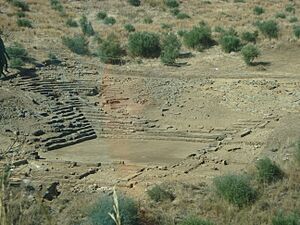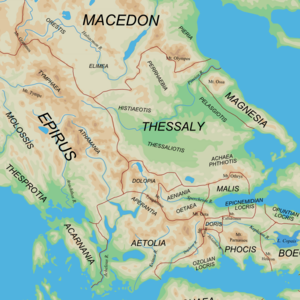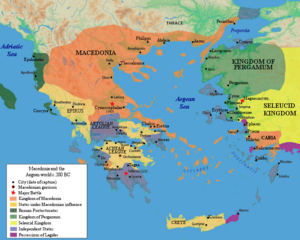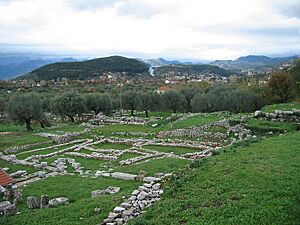Aetolian League facts for kids
Quick facts for kids
League of the Aetolians
Koinon tōn Aitōlōn
|
|||||||||
|---|---|---|---|---|---|---|---|---|---|
| 4th century BC–188 BC | |||||||||
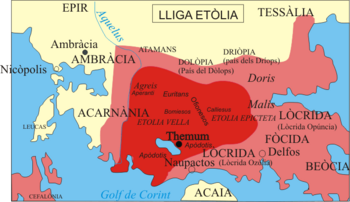 |
|||||||||
| Capital | Thermon (meeting place) | ||||||||
| Common languages | Doric Greek, Koine Greek | ||||||||
| Religion | Ancient Greek religion | ||||||||
| Government | Confederation of tribal communities and cities | ||||||||
| Strategos | |||||||||
| Legislature | Aetolian assembly | ||||||||
| Historical era | Classical Antiquity | ||||||||
|
• Established
|
4th century BC | ||||||||
|
• Treaty with Rome after the Roman–Seleucid War
|
188 BC | ||||||||
|
|||||||||
| Today part of | Greece | ||||||||
The Aetolian League (which means "League of the Aetolians") was a group of tribes and cities in ancient Greece. It was located in a region called Aetolia in Central Greece. This league was likely formed during the early Hellenistic era. It was created to stand against powerful groups like Macedon and the Achaean League.
The Aetolian League held two main meetings each year. These meetings took place at Thermon and Panaetolika. The league took control of Delphi around 290 BC. It slowly gained more land over time. By the end of the 3rd century BC, it controlled most of central Greece. Only Attica and Boeotia were not under its control.
At its strongest, the league's land included Locris, Malis, Dolopes, parts of Thessaly, Phocis, and Acarnania. Later, some Greek city-states joined the Aetolian League. These included cities like Mantineia, Tegea, Phigalia in Arcadia, and Kydonia on Crete.
During the classical period, other Greeks did not think highly of the Aetolians. They saw them as somewhat wild and reckless. However, the Aetolian League had a complex way of governing itself. Its armies were strong and could match other Greek powers. During the Hellenistic period, they became a major power in central Greece. They grew by having many Greek city-states join them willingly. The Aetolian League often fought against Macedonia. This led them to become allies with Rome. This alliance eventually led to Rome taking over all of Greece.
History of the Aetolian League
The Aetolians were a known group of people. They had a religious center at Thermos since at least the 7th century BC. During the Peloponnesian War, the Aetolians first stayed neutral. But when the Athenians tried to invade Aetolia in 426 BC, the Aetolians forced them to leave.
In the 4th century BC, the league quietly supported stronger states. They were rewarded for this. They received Aeolis from the Thebans in 367 BC. They also got Naupactus from Philip II of Macedon in 338 BC. The "League of the Aetolians" was founded sometime in this century. But the exact date is not known for sure. Some think it was founded by Epaminondas in 367 BC. Others believe it was later, around the time Philip II of Macedon became powerful. Old buildings and towns in Aetolia show that settlements grew bigger and more complex during this century.
After Philip II died in 336 BC, the Aetolians joined the Thebans. They fought against Alexander the Great. Their defeat caused the league to fall apart for a short time. Over the next ten years, it seems to have been put back together. Later in Alexander's rule, the Aetolians took Oeniadae even though he did not want them to.
The Aetolian League joined the Athenians in the Lamian war. This war was against Antipater after Alexander's death in 323 BC. They continued to fight against Macedonian power during the Wars of the Diadochi. They took part in invasions of Macedon in 320, 316/5, and 313 BC. Around 301 BC, the Aetolians took control of Parnassus. This included the important religious site of Delphi. They would control Delphi for over a hundred years.
Demetrius Poliorcetes started the Fifth Sacred War (289-287 BC). He tried to remove the Aetolians from Delphi. But he was defeated and driven out of Macedonia. This happened with help from Pyrrhus of Epirus. A Sixth Sacred War in 281 BC, led by Areus I, was stopped by the Aetolians alone. In 280 BC, they took control of Heraclea in Trachis. This gave them control over the very important pass at Thermopylae.
In 279 BC, the Aetolians won a battle against the Gauls. The Gauls had invaded Greece and were threatening the sanctuary of Delphi. After their victory, other Greeks admired them. They were then allowed to join the Amphictyonic League.
In 232 BC, the Illyrians, led by Agron, attacked the Aetolians. They managed to capture many people and valuable goods.
In 229 BC, the Aetolians fought in a sea battle near the island of Paxos. They were allied with Korkyra and the Achaean League. They were defeated by a group of Illyrians and Acarnanians. Because of this, the people of Korkyra had to let Illyrian soldiers stay in their city. These soldiers were led by Demetrius of Pharos.
In the Social War (220-217 BC), the Aetolian League fought against the Kingdom of Macedonia. Philip V of Macedon invaded Aetolia. He destroyed the city of Thermos. This was his response to the Aetolians invading the city of Dodona in Epirus.
The league was the first Greek ally of the Roman Republic. They sided with the Romans during the First Macedonian War (215-205 BC). They helped defeat Philip V of Macedon at the Battle of Cynoscephalae in 197 BC. This happened during the Second Macedonian War. However, the Aetolian League became more and more unhappy with Rome getting involved in Greek matters. A few years later, they sided with Antiochus III. He was the king of the Seleucid Empire and was against Rome. This happened during the Roman-Syrian War.
Antiochus was defeated in 189 BC. This meant the league lost its main foreign ally. It became impossible for them to stand against Rome alone. The league was forced to sign a peace treaty with Rome. This made them a subject ally of the Roman Republic. The league still existed in name, but its power was broken by the treaty. It never again had much political or military strength.
How the Aetolian League Was Run
The league had a federal structure. This meant it could raise armies and deal with other countries together. It also made economic rules the same for everyone. It collected taxes, used a common money system, and had the same weights and measures. There might not have been one central place for all official papers. However, the communities that made up the league had a lot of freedom. Sometimes the league could not (or would not) stop its members from fighting states they had treaties with. The league members were grouped into areas called tele (districts). These districts seemed to have some administrative and legal powers.
The league's main government had an assembly, a council, and several leaders. The Ekklesia (Assembly) was open to all citizens from all member communities. The assembly was the highest power in the league. It was in charge of declaring war and peace. But its power was limited because it did not meet very often. Two meetings happened each year. One was at the Thermica festival in Thermos during the autumnal equinox. The other was the Panaetolica festival in spring, which took place at a different location each year. Emergency meetings could also be called.
The exact jobs of the Council are not completely clear. It was called a boula or synedrion in different documents. It had delegates chosen by each member community. The number of delegates depended on the community's size. By the late 3rd century BC, it had about 1500 members. This was too many for it to meet all the time. A small part of the council, called the apokletoi ("Select-men"), handled daily tasks. These included sending and receiving messages from other states.
The league's archons (leaders) were chosen by the assembly each year at the Thermica festival. The main leader was the strategos (General). He commanded the league's armies. He also received all messages from other countries first. He led the meetings of the assembly, the council, and the select-men. A person could be General many times. But they had to wait, probably four years, before serving again. The hipparchos (Cavalry Commander) was a smaller role at first. But from the late 260s BC, he became the General's helper. His exact duties are not fully clear. The third in command was the Grammateus (Secretary). These three leaders were called Eponymous archons. This means their names were used to date all the league's official decisions.
From around 260 BC, there were also seven tamiai (Treasurers). There were also seven epilektarchoi (Commanders of the Elite). They managed money and military matters. There were also several boularchoi (Council Commanders). They seemed to guide the Council. When they first appeared in the 260s, there were two of them. But by the end of the 3rd century BC, there were six or more. This was probably because the league kept growing and adding more members.
From 278 BC, the league sent representatives to the Amphictyonic League (Delphic Amphictyony). Over time, the Aetolian League gained most of the seats on this council. This council then became a way for the Aetolians to show their power. From the 260s, the secretary of the Amphictyonic council was always an Aetolian. These representatives were likely chosen along with the other leaders at the Thermica festival. But their exact importance is not clear.
Piracy
The Aetolian League became known for piracy and robbery. Some historians think that ancient writers like Polybius were unfair to the Aetolian League. They believe Polybius favored the Achaean League. However, many modern historians agree that Polybius's description was mostly true. For example, historian Walbank clearly states that the Aetolians regularly used piracy to earn money. This was because their region did not have many resources. Another historian, Will, simply assumes that the charge of piracy was true.
On the other hand, historian Grainger believes that the Aetolians were probably not involved in piracy. He points out that they did not have the necessary ships for such activities.


